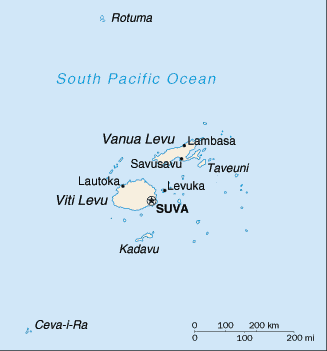Republic of the Fiji Islands
Related Categories:
 Flag of Fiji
Flag of FijiLight blue with the flag of the UK in the upper hoist-side quadrant and the Fijian shield centered on the outer half of the flag; the shield depicts a yellow lion above a white field quartered by the cross of Saint George featuring stalks of sugarcane, a palm tree, bananas, and a white dove. |
 National Symbols of Fiji
National Symbols of FijiFiji's flag flew for the first time on Independence Day, October 10, 1970. It includes the red, white and blue Union Flag of Britain in the top left-hand corner and the shield from the Fiji Coat of Arms on a light blue background in the fly.
www.fiji.gov.fj/publish/
Description and history of the flag, Detail of shield, Flag change proposal (2005), Presidential Standard, Civil Ensign, State Ensign, War Ensign, Civil Air Ensign, Military Flags, Coat-of-Arms.
www.fotw.us/
The first inhabitants of Fiji arrived from South East Asia long before contact with European explorers in the seventeenth century. Pottery excavated from Fijian towns showed that Fiji was settled before or around 1000 BC.
en.wikipedia.org/
Most of Fiji's population lives on Viti Levu's coasts, either in Suva or in smaller urban centers. The interior of Viti Levu is sparsely populated due to its rough terrain.
Indigenous Fijians are a mixture of Polynesian and Melanesian, resulting from the original migrations to the South Pacific many centuries ago. The Indo-Fijian population grew rapidly from the 60,000 indentured laborers brought from India between 1879 and 1916 to work in the sugarcane fields. Thousands more Indians migrated voluntarily in the 1920s and 1930s and formed the core of Fiji's business class. Native Fijians live throughout the country, while Indo-Fijians reside primarily near the urban centers and in the cane-producing areas of the two main islands. Nearly all of indigenous Fijians are Christian; more than three-quarters are Methodist. Approximately 80% of Indo-Fijians are Hindu, 15% are Muslim, and around 6% are Christian.
Some Indo-Fijians have been displaced by the expiration of land leases in cane-producing areas and have moved into urban centers in pursuit of jobs. Similarly, a number of indigenous Fijians have moved into urban areas, especially Suva, in search of a better life. Meanwhile, the Indo-Fijian population has declined due to emigration and a declining birth rate. Indo-Fijians currently constitute 37% of the total population, although they were the largest ethnic group from the 1940s until the late 1980s. Indo-Fijians continue to dominate the professions and commerce, while ethnic Fijians dominate government and the military.
www.state.gov/r/
Introduction
About
Contact
Symbols in The News
Interpret this Symbol
AAC
African
AI
Alchemy
Alphabets
Ancient
Animal Symbolism
Architecture
Art
Articles
Astrology
Baha'i
Blissymbolics
Blueprint Symbols
Buddhist
Celtic Symbols
Cemetery
Chinese Symbols
Christian
Circle
City
Codes
Color
Conlangs
Crop Circles
Danger
Da Vinci Code
Designing Logos
Dictionaries
Dreams
Education
Egyptian Symbols
Electrical
Emoticons
Find Images
Fonts
Food
Fraternity
Hamsa
Healing
Heraldry
Hermetic
Highway Signs
Hindu
History
Hobo
Holiday
Icons
iConji
Islamic
Jain Symbols
Japanese, Kanji
Jewish
Justice
Law
Literary Symbolism
Mandalas
Map
Masonic
Math, Number
Meaning of Names
Medical
Middle East
Military
Miscellaneous
Money
Music
Mythology
Native American
Playing Cards
Power
Psychology
QiQiiKhu
Reiki
Religious
Runes, Norse
Sacred Geometry
Scientific
Science Fiction
Sorority
Sports
Symbols in the News
Tattoos
ThirteenSymbols
Tree of Life
Ursprache
Videos
Visual Languages
Weather
Web Codes
Wicca
Words
Writing Systems
Braille
Coinherence
Coptic
Cuneiform
Easter Island
Etruscan
Happy Human
Hebrew
Kokopelli
Linear B
Lotus
Love Symbols
Mandorla
Moon Alphabet
Nine Pointed Star
Om
Oz
Phonetic
Scarab Beetle
Silent
Theosophy
Unifon
About
Contact
Symbols in The News
Interpret this Symbol
AAC
African
AI
Alchemy
Alphabets
Ancient
Animal Symbolism
Architecture
Art
Articles
Astrology
Baha'i
Blissymbolics
Blueprint Symbols
Buddhist
Celtic Symbols
Cemetery
Chinese Symbols
Christian
Circle
City
Codes
Color
Conlangs
Crop Circles
Danger
Da Vinci Code
Designing Logos
Dictionaries
Dreams
Education
Egyptian Symbols
Electrical
Emoticons
Find Images
Fonts
Food
Fraternity
Hamsa
Healing
Heraldry
Hermetic
Highway Signs
Hindu
History
Hobo
Holiday
Icons
iConji
Islamic
Jain Symbols
Japanese, Kanji
Jewish
Justice
Law
Literary Symbolism
Mandalas
Map
Masonic
Math, Number
Meaning of Names
Medical
Middle East
Military
Miscellaneous
Money
Music
Mythology
Native American
Playing Cards
Power
Psychology
QiQiiKhu
Reiki
Religious
Runes, Norse
Sacred Geometry
Scientific
Science Fiction
Sorority
Sports
Symbols in the News
Tattoos
ThirteenSymbols
Tree of Life
Ursprache
Videos
Visual Languages
Weather
Web Codes
Wicca
Words
Writing Systems
Braille
Coinherence
Coptic
Cuneiform
Easter Island
Etruscan
Happy Human
Hebrew
Kokopelli
Linear B
Lotus
Love Symbols
Mandorla
Moon Alphabet
Nine Pointed Star
Om
Oz
Phonetic
Scarab Beetle
Silent
Theosophy
Unifon
